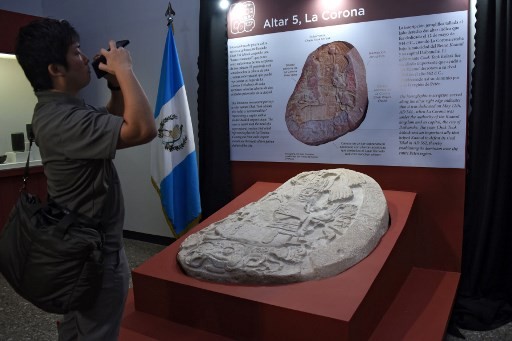Ancient altar reveals Mayan 'Game of Thrones' dynasty
Change Size
 A man takes a picture of a Mayan altar exhibited at the National Museum of Archaeology and Ethnology in Guatemala City on September 12, 2018.
The 1,500-year-old altar, discovered at La Corona archaeological site in northern Guatemala, evidences the political strategies of the dynasty of the Kaanul Mayan kings to control cities was similar to the popular TV series (AFP/Johan Ordonez)
A man takes a picture of a Mayan altar exhibited at the National Museum of Archaeology and Ethnology in Guatemala City on September 12, 2018.
The 1,500-year-old altar, discovered at La Corona archaeological site in northern Guatemala, evidences the political strategies of the dynasty of the Kaanul Mayan kings to control cities was similar to the popular TV series (AFP/Johan Ordonez)
A
1,500-year-old Mayan altar discovered in a small archeological site in northern Guatemala is drawing comparisons to popular fantasy drama television series "Game of Thrones" for its descriptions of the Kaanul dynasty's political strategies aimed at bringing entire cities under its control.
The altar, carved out of limestone and weighing around one ton was found at the La Corona archeological site in the jungle region close to the borders with Mexico and Belize, Tomas Barrientos, co-director of excavations and investigations at the site told journalists.
Barrientos said the altar was found in a temple and showed King Chak Took Ich'aak, La Corona's ruler, "sitting and holding a scepter from which emerge two patron gods of the city."
According to studies, the 1.46-meter by 1.2-meter slab contains a hieroglyphic Mayan inscription corresponding to May 12, 544.
Other discoveries have allowed researchers to determine that King Chak Took Ich'aak also governed the nearby city of El Peru-Waka some 20 years later.
Barrientos says these pieces of evidence show that the Kaanul dynasty, or Serpent Kingdom, developed a political movement in La Corona that allowed them to defeat their Tikal "arch rivals" in 562 and thereafter rule the Mayan lowlands in southeast Mesoamerica for two centuries.
Read also: 'Game of Thrones' castle up for sale in Northern Ireland
- 'Mayan Game of Thrones' -
That political movement was based around alliances with small cities surrounding Tikal ahead of the final victory push.
Alongside those revelations, researchers also found details of a wedding between a princess from the Serpent Kingdom and a King of La Corona, Barrientos said.
"This altar shows us a part of Guatemala's history and in this case, around 1,500 years ago, I would call this the historical Mayan version of Game of Thrones," he added, comparing the Kaanul kingdom's maneuvering to that in Game of Thrones of noble families competing over control of the seven kingdoms.
Barrientos said the altar "fills in the gaps" and "pieces together the puzzle" of the Mayan culture's political relationships.
"It's a high quality work of art that shows us they were rulers entering into a period of great power and who were allying themselves with others to compete, in this case, with Tikal."
La Corona "was the place where the most important historical Mayan political movement began to take shape."
The Serpent Kingdom expanded from its capital Dzibanche to present day north Guatemala, Belize and the Mexican state of Campeche but was finally defeated by Tikal.
- Dangerous excavations -
"Having information about what happened next, how they were plotting a political strategy here, teaches us a lot about politics in those times and the fight for territory," said Barrientos.
Excavating and investigating in the remote Mayan Biosphere Reserve where La Corona lies can be hazardous, though.
The region is constantly at threat from looting, invasions and incursions by criminal gangs, drug-traffickers and illegal ranchers, accused by environmentalists and authorities of starting forest fires that damage pre-Columbian monuments.
Culture deputy minister, Gladys Palala, told AFP that authorities are trying to counter encroachment by criminal groups besieging Peten, an area ripe with "archeological remains."
"Wherever you go and excavate, you find (something). It's an eminently archeological area," she said.
The Mayan culture reached its apogee during the classical period from 250-900 before going into decline over the next 300 years.









